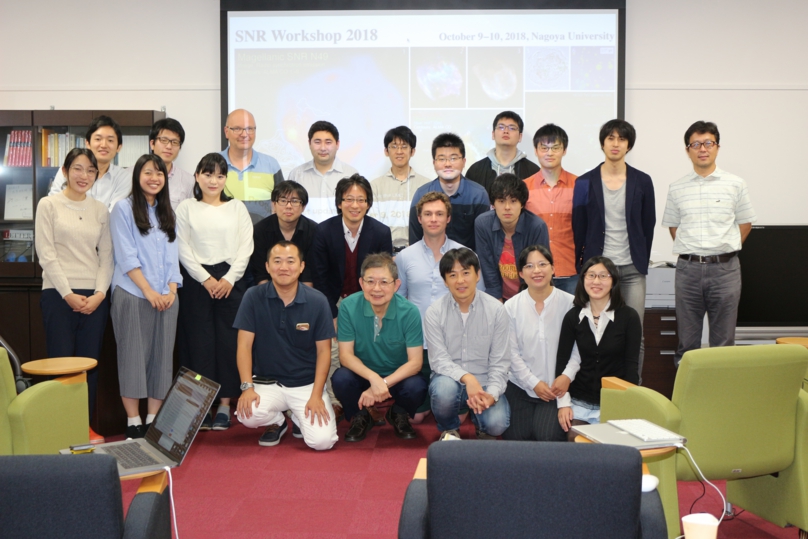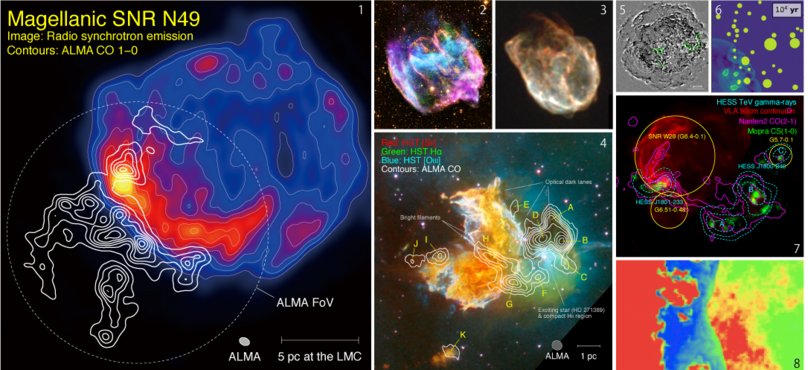Home
News
September 10, 2018 First circular.
October 4, 2018 Program and participants updated.
October 9, 2018 Program updated.
November 2, 2018 Talk slides and conference photo uploaded.
Conference Photo (Day2)

Scientific rationale
Supernova remnants (SNRs) are the most energetic objects not only in our Galaxy, but also in external galaxies, and have been observed at various wavelengths from radio to gamma-rays. One of the most spectacular features of SNRs is the fast moving expanding shells whose velocity is measured as ~3000-10000 km/s. Recent observations of the shells in X-rays as well as radio continuum emission have provided a wealth of information on their physical and kinematical properties. It is also remarkable that the dense interstellar medium interacting with the shocks is likely playing a key role to produce X- and gamma-rays as shown by comparisons with HI/CO and dust emission. Theoretical works on acceleration and escape of cosmic rays in SNRs are unveiling details of cosmic-ray acceleration/propagation by magneto-hydro-dynamical numerical simulations, which will be compared with observations. In the present workshop, we invite observers and theorists to stimulate active interaction and exchange of ideas on SNRs.
Hidetoshi SANO
Designated Assistant Professor
Institute for Advanced Research, Nagoya University
Time line
First circular: September 10, 2018
Workshop program: October 4, 2018
SNR Workshop 2018: October 9-10, 2018
Contact
sano@a.phys.nagoya-u.ac.jp
SOC
Hidetoshi Sano (Nagoya University)
Yumiko Yamane (Nagoya University)
Yasuo Fukui (Nagoya University)
Acknowledgment
This workshop was supported by JSPS KAKENHI Grant Number 16K17664 (Grant-in-Aid for Young Scientists (B), “大マゼラン雲の超新星残骸に付随する分子雲と原子雲”, PI: H. Sano)
Image credit
1. LMC SNR N49 (Yamane et al. 2018, ApJ, 863, 55) ADS Link.
2. Galactic SNR W49B (X-ray: NASA/CXC/MIT/L.Lopez et al.; Infrared: Palomar; Radio: NSF/NRAO/VLA).
3. LMC SNR N132D (Red: 0.5-1.2 keV, Green: 1.2-2.0 keV, Blue: 2.0-7.0 keV, Sano et al. 2015, ASPC, 499, 257) ADS Link.
4. LMC SNR N63A (Sano et al. 2018, submitted to ApJ) ADS Link.
5. Difference X-ray image between 2000 and 2014 observations of Cas A (Sato et al. 2018, ApJ, 853, 46) ADS Link.
6. Numerical simulations of SNR event in the cloudy ISM (Slavin et al. 2017, ApJ, 846, 77) ADS Link
7. Galactic SNR W28 (Maxted et al. 2017, AIPC, 1792, 0034) ADS Link.
8. 3D MHD simulation of the SNR shocks Propagating into the inhomogeneous ISM (Shimoda et al. 2015, ApJ, 803, 98) ADS Link.
